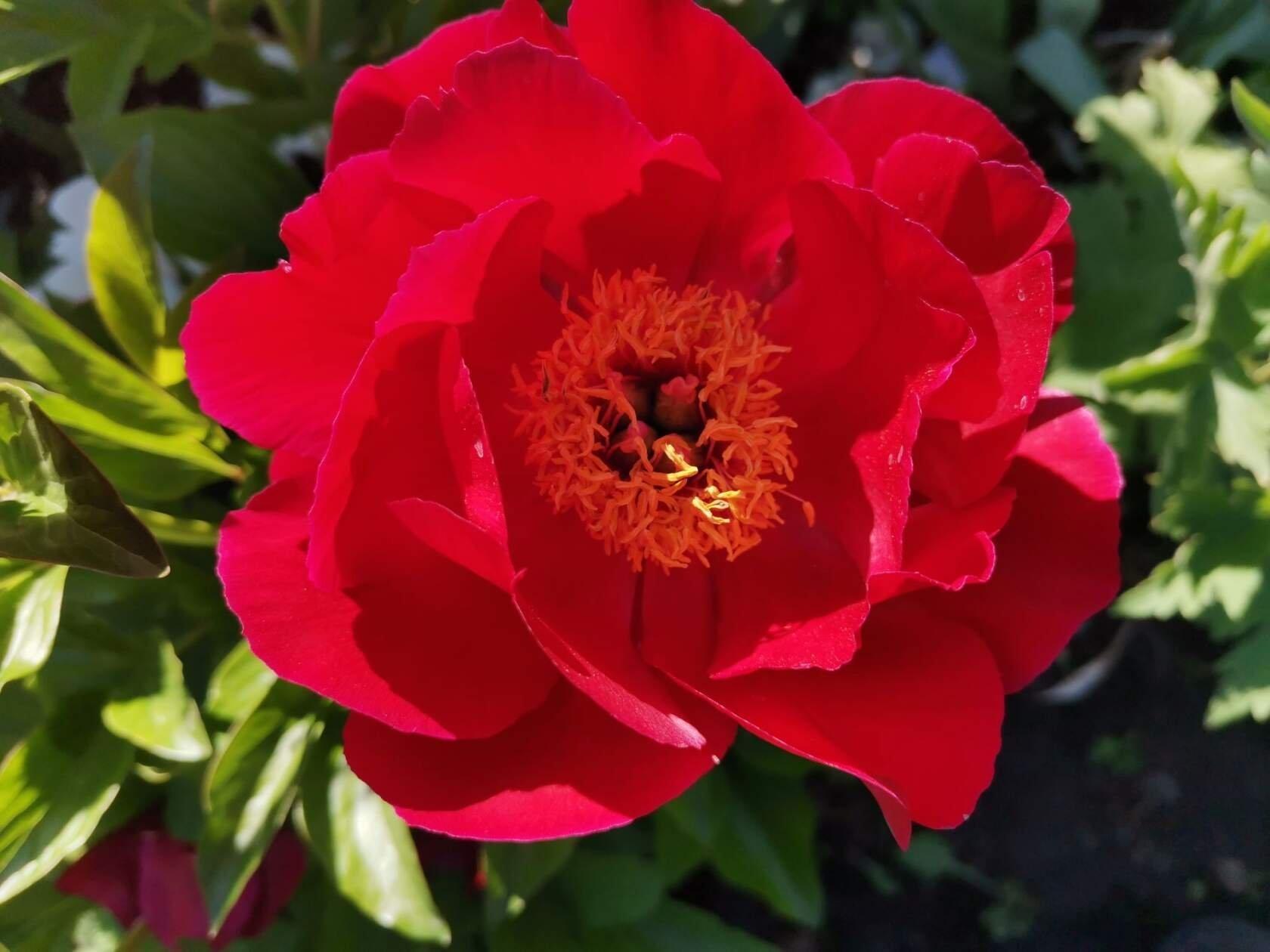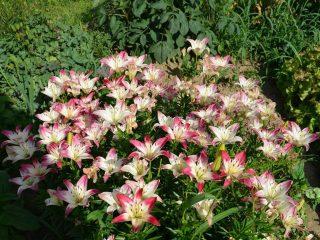Content
Peony Mackinac Grand is a colorful plant that can diversify the garden and bring an atmosphere of romance. Florists, summer residents and designers are equally partial to the bright red flowers of this variety. Peony attracts the attention of millions of gardeners around the world.
History of appearance
Mackinac Grand was grown in 1992 in the USA. The leading breeder is the Reath company. 11 years after breeding, the culture was awarded the AHS Award. In 2014, the plant became the best peony of the year.
Description of the Mackinac Grand peony with photo
The culture is a hybrid flower reaching up to 90 cm in height. It has strong stems and glossy green foliage. Mackinac Grand is a semi-double variety. The petals are concentrated around the bowl in 3-4 rows. At the beginning of flowering, they can be pink, orange or immediately red, like the flowers of adult plants.
Attention! Mackinac Grand peonies do not require support.

Mackinac Grand has acceptable winter hardiness and is suitable for planting in the Moscow region and the central part of the country
Sometimes peony is grown in Siberia and the Urals, but in this case additional care is required.
Timing and flowering period
The Mackinac Grand variety has beautiful flowering, which begins in the first half of June. The duration is short - only two weeks, but the flowers can be placed in a vase: they last more than 10 days, which is why florists “hunt” the bushes.
In the center of the large buds are golden stamens that contrast with the leaves. One bush can contain up to 60 flowers. When grown in open meadows, it is possible to obtain brighter specimens, while in forests and ravines – dark ones.
Advantages and disadvantages
Peony Mackinac Grand is not picky about care; it is even recommended for beginners who have never planted. The plant has other important benefits.

The culture is distinguished by its compactness, which is very important in landscape gardening.
Pros:
- early flowering;
- good immunity;
- large flowers;
- can be grown in partial shade and in light;
- does not require supports;
- fast growth.
Minuses:
- the root system suffers from waterlogging.
When and how to plant
Mackinac Grand peonies can be planted from early spring to mid-autumn. The gardener needs to pay attention to the size of the hole. 80 x 80 cm are considered optimal, but sometimes larger holes may be required - 100 x 100 cm. It is better to prepare them in advance so that the fertilizing has time to dissolve.
By the way, the fertilizer is made up of the following ingredients:
- humus;
- nitrogen;
- compost;
- peat.
All this is mixed with garden soil, after which the area is leveled.
When the time comes for planting, the fertilized area is dug up again. Peony Mackinac Grand is afraid of waterlogging, so drainage is placed at the bottom (in several layers, 5 cm each).
If the Mackinac Grand peony has a developed root system, long shoots are placed at an angle. They are buried and compacted by hand to prevent damage to the still fragile roots.

Part of the planting hole can be mixed with ash and sand - you get an extremely nutritious mixture that will provide peony for a long time
Care instructions
Peony Mackinac Grand is extremely easy to grow. To make the bushes lush, like in the picture, you need to pay attention to the following things:
- watering;
- weeding;
- loosening;
- feeding
The bushes do not need frequent moistening, but at the same time they require a large volume of water. In the spring, the soil is watered as the upper layers dry out (up to 4 cm), in the summer it is poured more often - always at the root. Closer to September, the procedure is stopped.
After watering, the soil needs to be loosened and weeded. The more regularly the gardener does this, the more noticeable the result will be.
As for fertilizers, they can be applied in liquid or dry form. It is better to use minerals in capsules, they are absorbed faster. Organics (due to the ammonia content) are used in moderate dosages.
The first addition is made in September of the following year. They start with potassium-phosphorus mixtures (sold in gardening stores), which stimulate growth. The second fertilizer can be applied two weeks after the first: organic matter is more appropriate here - a solution of rotted mullein. Feed for the third time after the appearance of stems and leaves.

Supplements can be repeated every month
Preparing for winter
When frost arrives, the mulch needs to be renewed.To survive the first winter, it is recommended to use spruce branches with peat, as it provides the best protection. The mulch is brought to a height of 20 cm. The young Mackinac Grand peony will require additional cover made of spunbond. By the third year there will be no need to protect the plant.
Reproduction methods
Mackinac Grand peonies are propagated by cuttings, division and growing layering. The last two methods are the most effective. In this case, it is possible to achieve early flowering and preserve the inherent characteristics of the variety.

Cuttings are carried out in the summer, when flowering ends.
Select viable shoots with several leaves. The foliage is reduced by 2/3, after which they begin to cut the cuttings. The optimal length is considered to be from 10 to 15 cm. The lower cut of the Mackinac Grand peony is dipped into a root development stimulator.
The cuttings are buried at an angle in a pot with nutritious soil. To imitate greenhouse conditions, peonies are covered with plastic cups. After the roots form, leaves will begin to appear. Then the cover can be removed.
Bushes over 5 years old are propagated by division. Necessary:
- dig up the roots and dry them;
- Having selected a bunch with renewal buds, make an incision and treat it with charcoal;
- plant in fertile soil.
The simplest method to obtain a daughter peony bush is propagation by layering. Work is carried out before the growing season, that is, in early spring. Healthy shoots are of interest - they are pressed to the ground and buried, leaving only foliage on the surface. After growing its own roots, the stem is separated and a year later transplanted to a new location.
Diseases and pests
Hybrid peonies have a common weakness - resistance to powdery mildew, rust and gray rot. To protect Mackinac Grand, the plant is treated with Fitosporin every season. It has a complex effect on the fungus and prevents its appearance.

In case of direct damage, if there is no Fitosporin, the root zone is sprayed with Bordeaux mixture. Experts also recommend the fungicide HOM
During the flowering period, the Mackinac Grand peony emits a sweet smell that attracts the attention of ants. They climb onto the buds and “pump out” plant juice. To drive away the pest, use the drug Fitoverm or Actellik. The same means give results in the fight against green aphids, which devour leaves.
Application in landscape

The presence of the Mackinac Grand peony helps to emphasize certain areas, zone the space and simply decorate the garden

The plant can become the central decoration of the lawn

Peony is usually planted in flower beds, next to other flowers or near borders.
Conclusion
Peony Mackinac Grand is an ITO hybrid variety recommended for planting in Voronezh, Moscow region, Krasnoyarsk, Izhevsk and Perm. The winter hardiness limit is -35 degrees. The bushes must be mulched for the winter, and young seedlings are additionally covered with spunbond or other non-woven material.
Reviews from gardeners about the Mackinac Grand peony








